The other day I stumbled upon a pair of articles titled The Ecology of the Goblin and The Ecology of the Kobold on the Blog of Holding. It reminded me that once upon a time I had this thing going where I would re-invent common fantasy races to make them interesting again. I did it for Orcs, and then for Elves. So, why not do Goblins next.
The first idea is sort of a conventional approach, but with a twist. In most settings Goblins are designed as low level enemies. You kill them by the dozen, and they always rove in large packs and are known to be week and cowardly. So my idea is, why not make this social, group behavior a more focal aspect of their society. What if they are not cowardly, but simply feel uncomfortable when not in a large group for the same reason why humans get loopy if they spend too much time in solitary confinement. What if they are just wired to be social?
The Social Network
The most prominent trait of Goblins as a species is that they are social. Out of all the “civilized” technology using races they are most group oriented. While each Goblin is perfectly capable of functioning as an individual, their psychology seems to be finely tuned to life in close, tight-knit groups. A great example of this is the fact that they have little to no concept of “personal space” or personal property. When left to their own devices Goblins will tend to pile up into tight huddles around their leaders. This is both a defensive tactic, as well as practical custom – anyone in the center of a huddle is also the center of attention and can effectively give orders. Usually such huddles are composed of about a dozen of individuals – sometimes more. When they gather in numbers they still tend to form these non-exclusive huddles, but individuals freely float between different groups carrying messages and spreading gossip.
A Goblin is happiest when surrounded by at least 4 or 5 of his brethren and chattering. Individuals that get left behind or somehow separated from their group and unable to find companionship quickly become bored, depressed, lethargic and moody. For that reason Goblins never work or travel alone – most tasks that would normally require a single individual are done in teams. The smallest group they are comfortable operating in is about half a dozen – but that’s cutting it close. If one or two members of that group get lost or wander off, the remainder will likely abandon the job as most Goblins feel uncomfortable and isolated in groups of three or less to the point they are unable to work or concentrate.
The upside of this social behavior is that Goblins are quick learners. They pick up new skills very quickly, and as soon as a single goblin figures out how to do something the knowledge rapidly spreads ac entire tribe. Most Goblins don’t learn a single trade skill or pick a life-long profession. Instead they pick up random assortment of skills as needed. When there is a job to be done an enterprising Goblin will simply Gather up his buddies who are not currently busy doing anything else, and they all pitch in. Those unfamiliar with the work pick it up as they go, and as long as majority of individuals in the group have an idea what they are doing things tend to get done. As you can expect, other races consider Goblin craftsmanship to be shoddy. It lacks the attention to detail and perfectionism born out of years of dedicated practice, or single unified vision of a skilled professional. Goblins mostly “wing it” and their creations “mostly work” or get patched and tweaked until they do.
In their natural habitat, given no pressures from the outside Goblins usually form tribal groups of around few hundred members. The exact population varies depending on food supply. Most tribes are opportunistic hunter-gatherers and they have a voracious appetite so usually there is an upper limit how large of a group they can support. Separate tribes are just likely to trade as they are to have armed skirmishes and territorial disputes. That said tribal membership is fluid. Goblins cast out of one tribe are likely to be assimilated and fully integrated by another. Weaker failing tribes are often swallowed up by stronger ones. A Goblin tribal will fight viciously to protect the interests of his kin, but if he is separated from his people he will usually join the enemy tribe and find new life there. This is known as Goblin loyalty – Goblins are loyal to whomever they are hanging out with. Their allegiances are fickle as a candle in the wind, and blood ties or personal history are close to meaningless.
Leadership positions in Goblin societies are usually temporary. The strongest, loudest and most persuasive Goblin is usually the de-facto leader that others will defer to. The power stems from their personal popularity and only lasts until someone more intimidating or charismatic shows up. It is not uncommon for an outsider to join a tribe, and become it’s leader in space of a week or two solely based on the strength of their character and their skill at networking. It is also not uncommon for a non-Goblin to “take over” a tribe – as long as they can out-wit or intimidate current leaders and win over crowd, Goblins will happily follow member of another race.
When their tribes compete on resources with other races, they tend to pattern their societies after their adversaries. For example, Goblins that live in the mountains tend to often fight against Dwarves. Well equipped, disciplined and trained unit of Dwarf warriors can easily steam-roll and pacify small tribe of few hundred Goblins without even breaking a sweat. So almost by necessity cave goblins sought protection in numbers. They build vast well defended underground Goblin-Towns that house thousands of individuals. To support their large populations they abandoned hunter-gatherer lifestyle and instead stole subterranean agriculture secrets from their enemies. Because Dwarfs are well armored usually fight in a tight phalanx formation, Cave Goblins started making crude shields and learned to pile up and stack vertically to attack from above. The constant competition for supplies and territory have shaped their lives. As a mockery of their bitter enemies, the Goblin-Town chieftain usually dons a looted Dwarf crown or ornate battle helmet and calls himself the Goblin-King.
The situation is completely different in the fertile plains where Goblins must compete with feudal kingdoms of men. Goblins are omnivorous opportunists with no real concept of property. To them an unattended field or an orchard is a plentiful food source not to be ignored. Thus men and Goblins tend not to get along. Men had found that the most effective defense against the Goblin menace is offense. Mounted units could effectively chase down and slaughter foraging parties and armed war parties with ease. As a defense mechanism Goblins learned to domesticate and breed wolves and use them as mounts. Being social sponges the Goblins were changed by the wolves as much as they changed them. Tribes were re-formed as small nomadic packs living off the backs of their animals lead by a alpha male. As wolves, they learned to use hit and run tactics targeting low risk/high reward targets – small poorly defended farms, merchant caravans, shepherds, etc.. This has proven to be a successful strategy, as the pack could effectively free or evade cavalry charge, relocate and strike undefended food supplies at a later time.
The Goblin Riders of the plains usually work in tandem – two riders to a wolf. One is the driver, whereas the other carries a short bow or few javelins for skirmish battles. When riding human settlements for supplies, the second rider dismounts and proceeds with the ransacking while the driver loads the saddle bags with obtained loot and is on the lookout for potential danger.
The affluent coastal regions with their sprawling human port cities are more hospitable. The merchants in the region saw the primitive local tribes of diminutive cheerful and impressionable little critters as a resource that could be exploited. Naturally, being the social sponges that they are local tribes have learned how to trade and barter. While still preferring communal living and sharing everything Goblins became pretty apt at recognizing what things human will trade, and how to calculate exchange rates. For example, gold is useless to goblins as its to soft for tools or weapons, and their social pecking order is usually established by yelling and brawling rather than by wealth. But they know that men crave gold above everything else so they trade in it.
The coastal tribes usually refer to themselves as trade companies lead by a “Chief Merchant” or “Merchant Prince”. Many abandon their native tongue and adopt local human dialects as their own. Most Coastal Goblins have rudimentary reading skills and pretty decent grasp of basic math. Their niche is that they will trade in anything. Nothing is beneath them, nothing is too illegal or too sacrosanct to be bought or sold. They are smugglers, money launderers and slave peddlers. The criminal guilds and syndicates love them, and local rulers turn a blind eye, especially since Goblin Trade Companies will eagerly pay high taxes to keep their sovereignty.
Goblins of the Darkwood Forest have been nearly driven to extinction by the Wood Elves who could not tolerate their presence in their forest. Fortunately the little adaptable beasts have found that the best way to survive was to live where Elves simply would not go. They made the least hospitable areas of the forest their home. They built floating raft villages in the swamps, and domesticated local water serpents and the giant spiders. Initially their hostile environment took it’s toll, and mortality was high. Over generations however, Forest Goblins built up tolerance to swamp gases, spider and snake venom adapting to their new territory. These days the swamps are teeming with them, and they are once again a thorn in the side of the Wood Elves – too numerous and too well entranced in their floating towns in the midst of toxic swamp.
One would think that creatures living in such hostile environment, taming poisonous beasts would be truly wretched and ugly. But Forest Goblins are actually the opposite. The over centuries the Elven aesthetics rubbed off on them and out of all Goblins they seem to be the cleanest and most well groomed. Their craftsmanship is still rather crude, but their clothing has a simplistic style and elegance to it. Their short bows are nowhere near as sturdy as the beautifully ornate longbows of the Elves, but they have a primal savage elegance to them.
Such is the Goblin kind – it finds a niche and adapts to it, morphing their society and their psychology to fit in. But regardless where they live, Goblins are always their own people. They may adopt customs, technologies or even languages of other races, but in the end they make them their own. They never loose sight of what it is to be a Goblin because… Well, they can’t. Their lack of individualism, their group dynamics and unique mob-psychology makes it almost impossible for Goblins to assimilate themselves into other cultures, but extremely easy for them to live side by side – either as adversaries or as allies.
Fey Folk
Magic winds flow through the world unimpeded by the physical matter. They pass through walls and living flesh with ease, racing across the land. They are invisible and imperceptible to anyone but mages and wizards who trained their minds to feel their flow. Those individuals can harness their power and use them to power their spells by the sheer force of will. But they are not the only people who affect the flow of these energies. Every sentient mind bends, attracts or repels the winds of magic a little bit. For example, negative emotions such as hatred, malice or jelaousy cause the free flowing magic to become dense, heavy and and syrupy. It slows, drips out of the air and pools into puddles collecting in shadows, cracks or dark places underneath your bed. It collects there, becomes denser and dense until it almost attains physical mass. Such pools of malice powered raw magic are where Goblins come from. They simply spring up from it over night – usually about a dozen at a time, sometimes more.
Their bodies are made out of raw magical stuff, and their minds are filled with the dark emotions that tainted the magic in the first place. They are little balls of lust, greed and hate. They hide during the day and come out at night to cause all kinds of mischief. They spoil food, they piss in the milk, break pottery, gnaw on ropes, cut and torture domesticated animals and generally prove themselves a nuisance. They usually leave sleeping men alone, though it is not unheard for them to torment little children by kicking their cribs, pulling their hair or stealing their blankets. When confronted they usually run, but will fight when cornered. They have sharp fangs and claws and the wounds they inflict may fester.
Goblins drastically vary in shape and size but most are diminutive in stature. Since they do not reproduce in normal way, they do not pass down or inherit traits. Each individual is unique, though they usually take after their hosts. So Goblins that spawn among elves will likely have spiky ears and lean, gaunt bodies, while those spawned in Dwarf households will tend to be stocky, hairy and frequently obese. While they don’t age, Goblins are far from immortal. They can starve to death, drown or be killed just like any other living thing.
Most Goblins will prefer to stay in the household where they have spawned. They are mostly parasitic – they feed themselves by raiding the pantries or steeling table scraps. While they posses near-human intelligence they are completely devoid of creativity. They know only how to destroy. If their hosts move out, Goblins will usually attempt to stow away in the baggage. If the hosts die, Goblins will leave the empty house and go in search of new place to live.
While social, they don’t really form communities. The individuals who spawned together usually stay together for the duration of their lives, though do a fair share or bickering and fighting. If two groups of Goblins meet, they will usually merge into one disorderly rabble, unless the is not enough resources. They will fight and kill each other over food.
Like all fay folk, Goblins are vulnerable to cold iron and banishment spells. Most sentient races consider them a menace to be stomped out, though it is not uncommon for sorcerers to bind them with spells and train them as minions.
Interestingly enough, intense positive emotions also affect the winds of magic. They make them rise up, and pool in the tree crowns or attics of houses filled with happiness. From those swirling pools of light and shiny magic spring fairies or sprites. They are lithe, winged and cheerful, and friendly but not much less of a nuisance as they too steal food and break household items.
Sprites and Goblins rarely find themselves living under the same roof, but if they must share space, they usually do it peacefully. Though driven by different emotions, and agendas they instinctively recognize each other as kin and will often eat or sing together.
The Flood
No one is sure where the Goblin plauge came from. Some theorize it was a biological weapon designed by a mad sorcerer. Others say it is a curse from the gods. One is certain – Goblins are a dangerous menace.
An average goblin is short, toothy violent and hungry. During the day he will attempt to eat about twice his body weight in food, then pass out for about 3-4 hours. During this short sleep, his body will process all the eaten food, his engorged belly will distend, then split and open up spilling forth a new fully formed Goblin. The new arrival shares most of the memories of his “father” but not necessarily his personality. Both will sleep for about two more hours, then rise and repeat the whole process again: they will eat till they can’t move anymore, fall asleep then split in two again.
As long as there is enough food to go around, Goblin population grows exponentially and balloons out of control. Let a lone Goblin into a city, and after ten days there will be over a thousand of those beasts running amok in the streets. All about as intelligent as a man, all consumed with ravenous hunger and completely devoid of morality – hell bent solely on satisfying own primal urges.
While week, cowardly and easy to kill Goblins pose incredible danger and are notoriously hard to get rid of. If even a single individual survives he can create a formidable army within days. In the past, Goblin plague flooded whole empires. Left unchecked their numbers swelled until it drowned out local population and exhausted local food resources. And they are not particularly picky – they will eat anything, including carrion. Stuff that cannot be eaten is useless to them, so they usually like to smash or burn it.
The only sure way to eradicate the plague is to mercilessly hunt them down, kill them and burn their bodies as they are incredibly resilient. Mortally wounded Goblins have been seen to bounce back to full health in mere hours, and it is not unheard off for a dead and decaying individual to “give birth” one last time before completely expiring.
Left unchecked Goblins will keep multiplying until they run out of food. They are not good swimmers and they don’t know how to build or sail boats so rivers and lakes tend to be natural borders that usually halt their progress. Same goes for mountains, cliffs or other difficult terrain features. Once they are left with no avenues to expand and no reliable food sources, Goblins usually turn on each other and revert to cannibalism. Usually an unchecked outbreak will extinguish itself within a few weeks, up to a month. However the Goblin menace doesn’t usually go away. Few individuals usually survive and go into hiding, subsiding on scraps and carrion. As long as they are near starvation levels they don’t reproduce. When other races return to the desolated area, and try to re-populate it and re-establish agriculture and commerce, Goblin problem tends to return fairly quickly.
—
So, how do you like these concepts? Which Goblins are your favorite? WoW? Warhammer? Harry Potter? Magic the Gathering? Let me know in the comments.
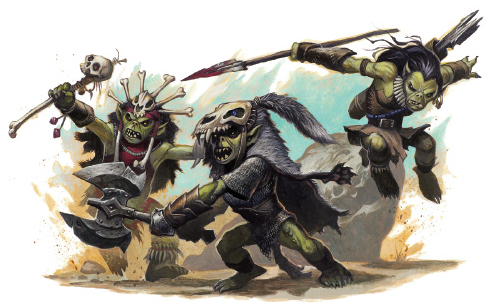
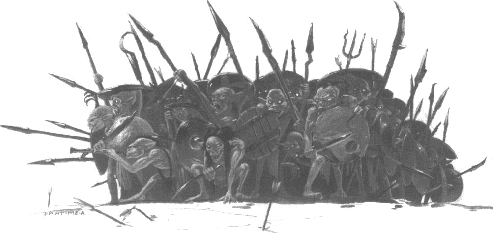

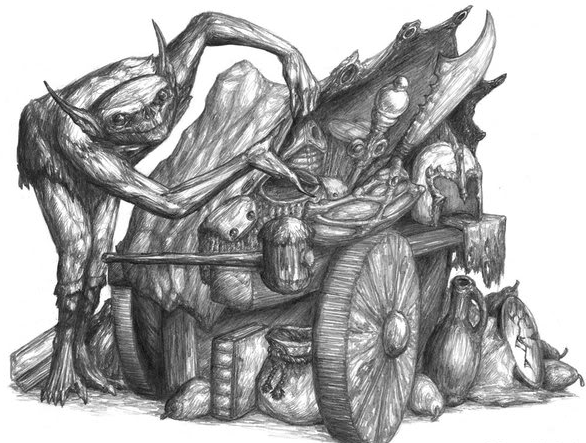
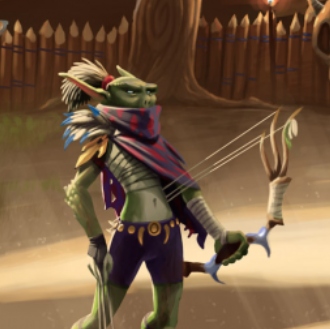
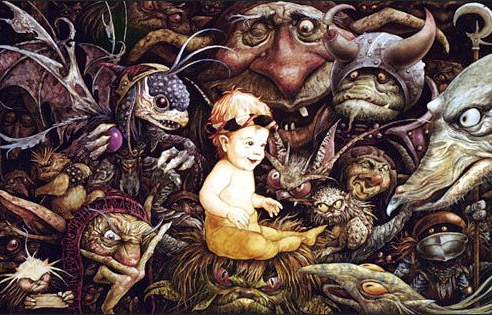
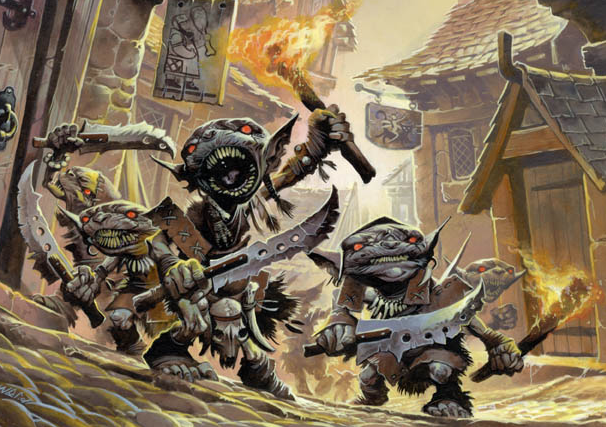
I liked the first one – the adaptable niche-fillers, stumbling along with a grab-bag of skills and a group mentality. That seems like something that could be used to flesh them out into more than a kind of vermin. Lets you imagine docile goblins, grown fat on successful trade, rather than an endless horde of barbarians.
That said, maybe goblins are better as barbarians, eating and pillaging and never really stopping. In which case your exponentially growing Flood would fit right in, although the non-existent gestation time and massive traumatic injury involved in birthing a new goblin stretched credulity for me.
@ Matt`:
Well, I sort of envisioned the “flood” version as a magical bio-weapon designed by some evil wizard. So the fast gestation is aided by some magic processes that are not readily understood because no one has really observed Goblin reproduction in controlled conditions. It’s not like you can just go and nab some Goblins to experiment with, and the outbreaks are more or less natural disasters.
Which could actually be an adventure hook. A wizard hires the party to capture some live goblins in an “infested area” to bring them back to his lab to be studied. Tons of things can go hilariously wrong along the way.
I love the Flood Goblin version. The only thing I think I would add is a kind of torpor or hibernation period as a part of their physiology, much like insects that run in cycles. It would allow for a natural rhythm to form even in the extended absence of other races, and allow settling parties enough time to establish themselves and perhaps be reluctant to leave the area.
Just one question. If they only care about eating how does a Flood Goblin obtain weapons or armor?
@ Mitlik:
Yes! I absolutely love the hibernation idea. Let’s say that once their food supply dwindles down to zero, they start burrowing in the ground and go into dead-like torpor state. The wake up mechanism is related to biological activity in the soil – as Goblins will usually leave an area a desolate wasteland given enough time. Once plant life starts to re-grow and there are nutrients in the soil, the Goblins get activated again.
Mitlik wrote:
Oh, they are pretty intelligent tool users – they were engineered to be very adaptable. They don’t build tools, but they can learn to use the ones they find. Remember that when they “split” both resulting goblins retain the same memories. So each new outbreak is actually more experienced and more efficient than the last one, because the goblin which survived, and triggered the relapse “remembers” what went down last time.
So it is not unthinkable that when faced with organized and armed resistance, The Goblin Flood would over decades learn to scavenge and use weapons and armors from fallen foes.
Pingback: Ravenflight Part 3: My green dudes are different | Terminally Incoherent

I quite like your first version of goblins. When designing a fantasy world I found I was very quickly putting dwarves in the mountains, elves in a remote forest and have humans inherit the Earth. this’ll help counteract that.